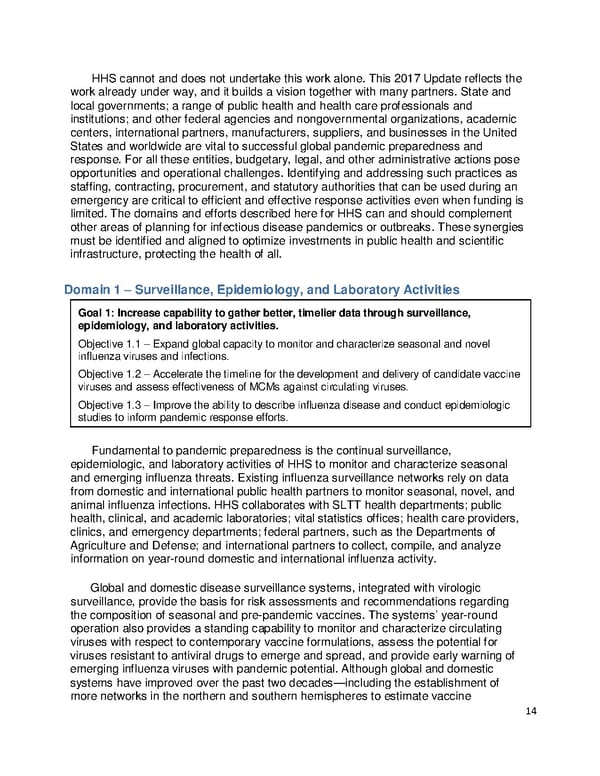HHS cannot and does not undertake this work alone. This 2017 Update reflects the work already under way, and it builds a vision together with many partners. State and local governments; a range of public health and health care professionals and institutions; and other federal agencies and nongovernmental organizations, academic centers, international partners, manufacturers, suppliers, and businesses in the United States and worldwide are vital to successful global pandemic preparedness and response. For all these entities, budgetary, legal, and other administrative actions pose s. Identifying and opportunities and operational challenge addressing such practices as staffing, contracting, procurement, and statutory authorities that can be used during an emergency are critical to efficient and effective response activities even when funding is limited. The domains and efforts described here for HHS can and should complement other areas of planning for infectious disease pandemics or outbreaks. These synergies must be identified and aligned to optimize investments in public health and scientific infrastructure, protecting the health of all. Domain 1 – Surveillance, Epidemiology, and Laboratory Activities Goal 1: Increase capability to gather better, timelier data through surveillance, epidemiology, and laboratory activities. Objective 1.1 – Expand global capacity to monitor and characterize seasonal and novel influenza viruses and infections. Objective 1.2 – Accelerate the timeline for the development and delivery of candidate vaccine viruses and assess effectiveness of MCMs against circulating viruses. Objective 1.3 – Improve the ability to describe influenza disease and conduct epidemiologic studies to inform pandemic response efforts. Fundamental to pandemic preparedness is the continual surveillance, epidemiologic, and laboratory activities of HHS to monitor and characterize seasonal and emerging influenza threats. Existing influenza surveillance networks rely on data from domestic and international public health partners to monitor seasonal, novel, and animal influenza infections. HHS collaborates with SLTT health departments; public health, clinical, and academic laboratories; vital statistics offices; health care providers, clinics, and emergency departments; federal partners, such as the Departments of l partners to collect, compile, and analyze Agriculture and Defense; and internationa information on year-round domestic and international influenza activity. Global and domestic disease surveillance systems, integrated with virologic surveillance, provide the basis for risk assessments and recommendations regarding the composition of seasonal and pre-pandemic vaccines. The systems’ year-round operation also provides a standing capability to monitor and characterize circulating viruses with respect to contemporary vaccine formulations, assess the potential for viruses resistant to antiviral drugs to emerge and spread, and provide early warning of emerging influenza viruses with pandemic potential. Although global and domestic systems have improved over the past two decades—including the establishment of more networks in the northern and southern hemispheres to estimate vaccine 14
 Pandemic Influenza Plan Page 13 Page 15
Pandemic Influenza Plan Page 13 Page 15